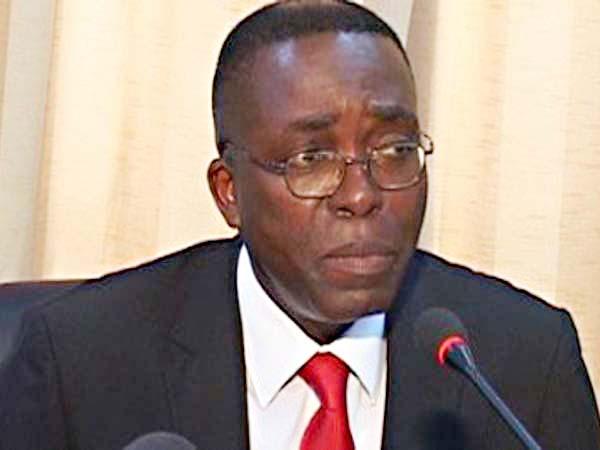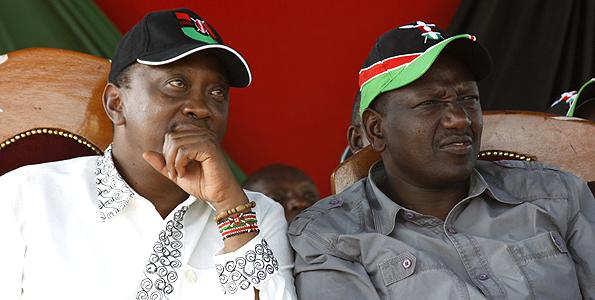Waiting for a miracle in Congo: a peace process with many processes and no peace – By Kris Berwouts


Congo's Prime Minister Matata Ponyo could be thrown in to the wilderness if PPRD barons and party apparatchiks get their way.
Congo is on hold
After M23 left Goma in early December, the military situation around the town stagnated. Apart from some repositioning in the hills around North Kivu’s biggest town, the situation has remained calm. People have been anxiously awaiting the outcome of the negotiations between the government and M23 in Kampala.
They are also waiting for the much discussed “˜neutral force’ to arrive. The idea of such a force was first launched through discussion within the International Conference for the Great Lakes Region (ICGLR) – an organisation that brings together Kenya, Congo and its nine immediate neighbours. The ICGLR is, however, still young and lacks commitment and ownership by its eleven member states, so nobody really took the idea seriously. But on December 9th it was given greater impetus when SADC decided to contribute troops. Since SADC is a much stronger structure, this decision made the neutral force all of a sudden much more likely. Despite this, the “Congo is on hold” feeling has only became stronger over these last weeks.
A semblance of negotiations
The Kampala negotiations progressed painfully slowly. For both parties, just being there seemed more important than actually achieving anything. But both still wanted to show their good will and readiness to talk. The government also needed to buy some time. The fall of Goma had clearly demonstrated the weakness of the national army in the field. The military power balance in North Kivu can only be changed by the arrival of the neutral force, in the meantime the government needs to develop the feeling that something is happening.
Much of the talk revolved around how talks should take place, who should do the talking and what they should talk about. M23 wanted to frame the negotiations very broadly – they would not only be about the recent violence in North Kivu and an evaluation of the agreements of March 23, but also address themes such as the elections, the reform of the state and the army and the main social issues. In the end, talks did take place between the two parties, but more often through the Ugandan facilitator than directly.
A mini-success
In February, a document was eventually paragraphed (not even properly signed) where both parties evaluated the agreements of March 23, 2009 and recognized that they have not been executed in their entirety. It is a long and technical document acknowledging that 23 of the 35 points both parties agreed on in 2009 have been (or are being) implemented according to the text, while the 12 others have not been executed. This text means that everyone has escaped with his dignity intact: the government has done a lot, the M23 has a point when it says there’s much still to do.
One important theme, on which no solution has been found, is how to demobilise and reintegrate M23 after the end of the hostilities. The government proposes integrating everybody below the rank of major back into the army, and to redeploy them (after additional training) in different provinces. The officers ranked major or higher could be sent back into civilian life with a demobilization package. The highest level of the leadership (including Bosco Ntaganda and Sultani Makenga) would be arrested and submitted to Congolese or international justice. This last point is obviously not an option for M23.
The main merit of this evaluation of the March 23 Agreement, is that it exists – it can be presented by both parties as some sort of mini-success, even if it is a rather unimpressive type of mini-success.
The two delegations left Kampala a week ago, and two small teams of technicians remain behind to maintain the impression that real work is being done, even if everybody understood from day one that Kampala could not create sustainable solutions aimed at the root causes of the conflict. If they hadn’t continued the work, the risk of new violent confrontations in North Kivu would have immediately increased. M23 has recently reinforced its positions in the hills around Goma and on their side of the border Rwanda did the same. The threat of renewed violence around the city or elsewhere in the province is very real.
Framework Agreement
In December, many people had the impression that the neutral force could be mobilized quite quickly. But since then the process leading to it materialising has slowed because of the complex operational and practical issues around it. Additionally, there have been political tensions on two levels. The first level of disagreement is between the different African institutions/regions and the United Nations. The second is between the African institutions/regions themselves. They all crystallised around the Framework Agreement which was elaborated and proposed by a very small group of people, steered directly by the office of United Nations Secretary General, Ban Ki Moon.
The Agreement includes a commitment by Congo and the most important countries in the region (including its immediate neighbours and South Africa) and the international community (UN, EU, AU…), focusing on democratic and security sector reforms and economic recovery. As part of the Framework Agreement, a UN Special Envoy for Central Africa will be appointed, who will coordinate a Comité de Suivi. The neutral force, between 2,500 and 4,000 strong, will be part of that constellation.
The Framework Agreement was proposed in December and submitted for signature in Addis Ababa at the African Union Summit in January. At the last minute, South Africa refused to sign, due to what they considered to be the lack of transparency in the process (it was indeed prepared by a very small group of people around Ban Ki Moon). The agreement also proposed expanding the group of African countries actively involved in it (with, among others, Mozambique – presently the chair of SADC). In more operational terms, South Africa and SADC strongly objected to the way the neutral force would be integrated in to Monusco’s (the UN peacekeeping force already deployed in the DRC) structure.
Once South Africa had blocked the process, Congo also formulated its grievances. Kabila’s government strongly objected to any proposal resembling the Committee to Support Transition (CIAT). The Congolese also wondered why they should be forced to reform their democratic institutions when they don’t consider countries such as Rwanda and Uganda as being particularly exemplary in this regard.
Elephants
The talks advanced, but painfully slowly. The United States vetoed the possibility of a neutral force outside of Monusco and SADC will not deploy its own troops without being in command. A similar struggle took place between the African institutions, with poles of power as different as ICGLR, SADC, the East African Community and the African Union further complicated by bilateral affinities or allergies between individual countries.
It looks like the Framework Agreement will be signed soon – at the end of February or early March. Then of course, the neutral force still has to be formed. The most optimistic estimate I heard in Kinshasa is that it could be deployed by the end of June. Sceptics doubt that it ever will be. Even with a signed Framework Agreement, the political, financial and operational challenges remain huge. As long as it is not deployed, the situation in the field is precarious – M23 knows that it is the strongest military player in the field. This will no longer be the case when and if the neutral force arrives. If they decide to take Goma before that, they can do so in an hour or three (with a little help of their friends, of course).
It is interesting to see how countries and continents organize themselves around Congo and the interests it represents. The positioning and pressurising reveal a changing world order and are therefore are fascinating to follow. It is difficult to translate the immediate results and impact of that power game into a clear idea of what is best for the Congolese population in the long run. I tend to believe in African proverbs, including the old adage that says: “No matter whether two elephants make love or fight, it will always be the grass that suffers.”
Cohesion
In December, President Kabila announced a process to increase national cohesion. Nobody can be against that, of course, but what exactly are we talking about? The only certainty is that different people and groups will be imagining very different concepts with very different motivations. Parts of the opposition see this as a moment like the Inter-Congolese Dialogue in 2002 and an opportunity to redistribute the cards. Some people within the government see it more as a consultation on the big challenges lying ahead – a sort of round table, preferably as technical as possible. They don’t even want to use the term “˜dialogue’ anymore and prefer to talk about “˜consultations’. The Congolese Civil society, having lost much of its own coherence and impact over the last ten years, is very divided over it too.
Obviously, the PPRD barons and party apparatchiks around Secretary-General Boshab see this as an excellent occasion to get rid of Prime Minister Augustin Matata Ponyo, who was appointed nearly a year ago. Considered a technocrat and an expert on financial and macro-economic issues, Matata started to reform the administration, injecting bits of good governance and installing mechanisms of control which go straight against the interests of those who controlled the ship of the state before him. They wouldn’t be at all averse to sending “˜le petit’ into the desert as a scapegoat.
The “˜moderate’ opposition wants to have a political agreement which gives them a place in the government, and the “˜radicals’ around Tshisekedi will use the occasion to state again that everything that followed the elections of November 2011 is illegitimate and counter to the constitution.
An eternal transition?
The main pitfall in this search for cohesion is that it will lead to another transitional constellation, thus eternalising the transitional period the country has been in since the day Mobutu declared he would open up the political space, in April 1990. An important faction of the ruling party is actively trying to orient the process in this direction. This would allow them to skip the local elections and, with a change made to the Constitution, even the elections of 2016, so remaining in power (without Matata).
Another segment of the ruling party absolutely wants to stick to the logic and timetable of the electoral scheme established since 2006 and prepare for decent elections in 2016 which would be the start, if the Constitution is respected, of the post-Kabila era.
So there is a lot of talk about dialogue these days here in Kinshasa. Will that bring back a bit of legitimacy or national cohesion after the failed elections and one year of M23? I doubt it. I don’t easily believe in miracles. But after all, this is Congo, where nothing ever seems to work but everything remains possible.
Kris Berwouts has, over the last 25 years, worked for a number of different Belgian and international NGOs focused on building peace, reconciliation, security and democratic processes. Until recently, he was the Director of EurAc, the network of European NGOs working for advocacy on Central Africa. He now works as an independent expert on Central Africa.






[…] defies reality. The Kampala talks have stalled over intractable issues and most of the major players have gone home. Getting the two sides to agree that the March 23, 2009 agreement failed to be implemented is the […]
[…] about what may be lie ahead for the DRC. Kris Berwouts raised this point at the end of a piece for African Arguments on a DRC peace deal shortly before it was announced writing, “So there is a lot of talk […]
[…] launched with a leading role for UN Secretary General Ban ki Moon himself, which materialised in a Framework Agreement for the Great Lakes region. That Agreement, signed on February 24th 2013, involved not only Congo and its immediate […]
[…] launched with a leading role for UN Secretary General Ban ki Moon himself, which materialised in aFramework Agreement for the Great Lakes region. That Agreement, signed on February 24th 2013, involved not only Congo and its immediate […]